
Scientists may have found an explanation for the mysterious, eccentric orbits of objects far beyond Neptune in our solar system.
New research suggests that billions of years ago, a star passed very close to our solar system, causing a major disturbance.
This event could have thrown thousands of celestial bodies, known as trans-Neptunian objects, into strange, highly inclined orbits around the sun.
Some of these objects may have even been captured by Jupiter and Saturn, becoming moons of the giant planets.
These findings come from a team of astrophysicists at Forschungszentrum Jülich in Germany and Leiden University in the Netherlands.
Their research was published in two studies in the journals Nature Astronomy and The Astrophysical Journal Letters.
What are trans-Neptunian Objects?
When we think of our solar system, most people imagine it ending at Neptune, the outermost known planet. However, thousands of objects, called trans-Neptunian objects, orbit the sun beyond Neptune.
Many of these objects are small, but some are as large as 100 kilometers or more in diameter. What makes these objects especially puzzling is that many of them have very eccentric (elongated) orbits, and their paths are tilted compared to the plane where most of the planets orbit.
Astrophysicists Susanne Pfalzner, Amith Govind, and Simon Portegies Zwart wanted to understand what could have caused these unusual orbits.
Using more than 3,000 computer simulations, they explored the idea that another star may have passed close to our solar system in the distant past. The team found that a near flyby of a star could explain the strange, tilted orbits of trans-Neptunian objects.
“The best match we found was a star slightly smaller than our sun—about 80% of its mass,” explained Govind. “This star passed by our solar system about 16.5 billion kilometers away, roughly four times the distance of Neptune from the sun.”
This close encounter could also explain the orbit of distant objects like the dwarf planet Sedna, which has an extreme, elongated orbit, as well as two objects—2008 KV42 and 2011 KT19—that orbit in the opposite direction to the planets.
New explanation for strange moons
The scientists made another surprising discovery. Their simulations showed that some of the trans-Neptunian objects may have been hurled inward towards the giant planets—Jupiter, Saturn, Uranus, and Neptune. These objects could have been captured by the planets, becoming moons.
This finding could explain why some moons of the outer planets are very different from others. Most moons orbit their planets in regular, circular orbits, but some moons, known as “irregular moons,” have strange, elongated orbits that are tilted compared to the planet’s equator. In some cases, these moons even orbit in the opposite direction, as is the case with Saturn’s moon Phoebe.
“Until now, we didn’t have a good explanation for why these irregular moons exist,” said Portegies Zwart. “But this star flyby model provides a simple and natural explanation for their unusual orbits.”
The researchers are excited by how this new model answers several long-standing mysteries about our solar system. “The beauty of this model lies in its simplicity,” said Pfalzner. “With one single event—a passing star billions of years ago—we can explain both the eccentric orbits of trans-Neptunian objects and the strange moons of the giant planets.”
While more research is needed to confirm this theory, the study offers a fascinating glimpse into the possible history of our solar system and how forces from outside could have shaped it.
Source: KSR.



